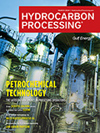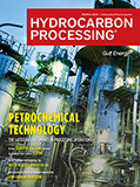Octane
HP Industry Metrics
The global market is experiencing a potential temporary recovery from a prolonged decline, possibly followed by the continuation of the downtrend. This is reflected in continued growth in the US tight..
2015 Catalyst developments: Innovation and value creation
Hydrocarbon Processing invited major catalyst companies and industry consultants to share their insights regarding innovations and trends for new catalytic technologies.Challenges to be solved“As..
Hydrogen perspectives for 21st century refineries—Part 2
H2 is the lifeblood of 21st century refineries. The application of various technological advancements and core developments has been raising the bar in the design, build, operations and maintenance of H2 facilities.
Case history: Innovative resid-cracking catalyst debottlenecks FCC unit
Tamoil is a major operator in the oil and energy industry with operating refineries in Hamburg, Germany, and Collombey, Switzerland, in addition to distribution networks in Italy, Germany, Switzerland..
Consider the pros and cons when importing heavy oil for cokers
The recent shift to lighter crudes has starved many US heavy oil units of feed. Maximizing asset use makes importing heavy oil for vacuum distillation and delayed coking attractive.
FCC 101: How to estimate product yields cost-effectively and improve operations
The feed to fluid catalytic cracking unit (FCCU) is the most important process variable. FCCU feed has the greatest impact on operating conditions, yield and product quality. A typical FCCU feed consi..
What are the possible impacts on US refineries processing shale oils?
No singular event has had as significant an impact on the quality of refinery feedstocks as the shale revolution. Not only are shale crudes, such as Eagle Ford and Bakken, generally lighter than other..
Consider new online analyzers to optimize FCC operations
Nuclear magnetic resonance (NMR) and near infrared (NIR) process analyzers are highly effective in quantifying physical properties in hydrocarbons, especially where the feedstock, intermediate and final product streams are all interlinked.
HP Editorial Comment: Take a moment and breathe
“Don’t panic” is probably the best advice for the downstream industry regarding oil prices. The upstream fully recognizes the present and short-term conditions for its business.
HP Global: 2015 outlook for oil price and its refining sector implications
What is the oil price outlook for the next 12 months? As of early January, the price of Brent has effectively halved compared to the 2014 summer peak, similar to the price collapse of 2008. However, u..

- KBR's phenol technology selected by SABIC Fujian Petrochemicals 4/25
- Honeywell Technology helping to produce SAF with lower cost and waste 4/25
- Nigeria's NNPC partners local firm on new 100,000 bpd refinery 4/25
- Stranded cargo shows credit challenges at Nigeria's Dangote refinery 4/25
- Low U.S. distillate consumption reflects slow economic activity and biofuel substitution 4/25
- Clariant catalysts reduce customers’ footprints by 40 million tons of CO2e in 2023 4/25




